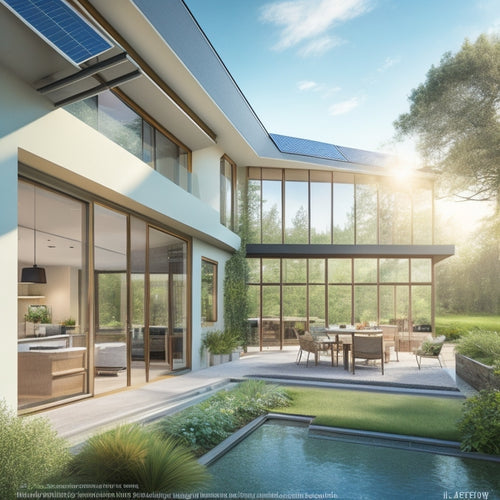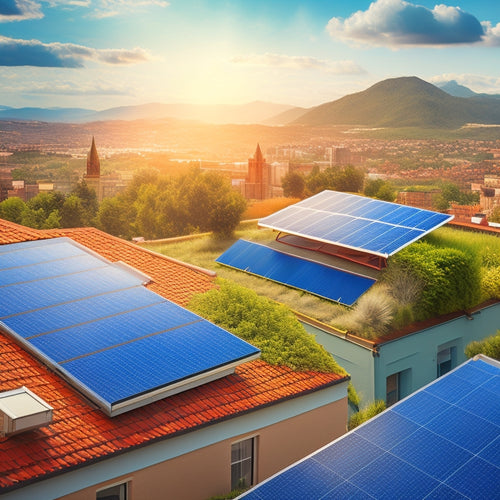
3 HVAC Zoning Secrets for Eco-Friendly Home Energy Savings
Share
You've likely invested in an eco-friendly HVAC system, but did you know that you're probably still wasting energy and money because of inefficient zoning. By dividing your home into distinct zones, you can target specific areas for heating or cooling, reducing energy waste and consumption. Smart thermostat integration takes it a step further, allowing you to monitor energy usage, customize temperature profiles, and identify inefficiencies. To maximize your energy savings, you'll need to optimize your HVAC performance by evaluating duct design, load balancing, and upgrading to smart zone controllers - and that's just the beginning of revealing your system's full potential.
Key Takeaways
- Dividing your home into distinct zones for targeted heating and cooling reduces energy waste and lowers utility bills.
- Integrating smart thermostats enables real-time energy monitoring, customized temperature control, and automation for maximum energy savings.
- Proper duct design, sealing, and insulation are crucial to prevent energy loss and ensure efficient heating and cooling.
- Load balancing across zones ensures efficient energy distribution, and upgrading to smart zone controllers improves zone control efficiency.
- Redesigning zoning layout can significantly enhance overall HVAC system performance and energy efficiency.
Zoning Systems for Energy Efficiency
Across various climates and regions, homeowners are constantly seeking innovative ways to optimize their heating, ventilation, and air conditioning (HVAC) systems for improved energy efficiency.
You're likely no exception, and that's why you're considering a zoning system for your home. By dividing your home into distinct zones, you can enjoy significant zoning benefits, including improved temperature control.
With zoning, you can heat or cool only the areas of your home that need it, reducing energy waste and lowering your utility bills. Furthermore, incorporating renewable energy sources, such as solar-powered stations, can further enhance your energy savings.
Additionally, understanding the installation costs and incentives for commercial EV charging stations can provide useful perspectives for homeowners exploring eco-friendly options.
This precise temperature control also means you can customize the comfort level of each zone to suit your needs, giving you the freedom to create the perfect environment for relaxation or productivity.
Smart Thermostat Integration Secrets
Your HVAC zoning system can reach new heights of energy efficiency when paired with a smart thermostat. This integration allows you to optimize your heating and cooling system's performance by leveraging advanced thermostat features.
By incorporating sustainable energy practices, such as solar-powered charging solutions, you can further reduce your carbon footprint. First, verify thermostat compatibility with your zoning system to avoid any control conflicts.
Next, employ energy monitoring capabilities to track your energy consumption in real-time. This data enables you to identify areas of inefficiency and make adjustments to your zoning strategy.
By integrating a smart thermostat, you'll gain precise control over your system, allowing you to create customized temperature profiles, schedules, and automation rules.
This fusion of technologies enables you to take charge of your energy usage, releasing maximum savings and freedom from energy waste.
Maximizing Energy Savings Potential
The key to maximizing energy savings potential lies in enhancing your HVAC zoning system's performance by identifying and addressing areas of inefficiency. This requires an extensive exploration of your system's duct design and load balancing. You'll want to verify that your ducts are properly sized, sealed, and insulated to prevent energy losses. Additionally, balancing the load across different zones verifies that each zone receives the right amount of heating or cooling.
| Zone Characteristic | Optimization Strategy | Energy Savings Potential |
|---|---|---|
| Uneven room temperatures | Implement load balancing | 10-15% |
| Leaky or uninsulated ducts | Seal and insulate ducts | 5-10% |
| Inefficient zone control | Upgrade to smart zone controllers | 8-12% |
| Oversized or undersized equipment | Right-size equipment for each zone | 12-18% |
| Inadequate zoning design | Redesign zones for maximum performance | 15-20% |
Frequently Asked Questions
Can Zoning Systems Be Installed in Existing Homes or Only New Constructions?
You can retroactively install a zoning system in your existing home with some modifications, enabling zoning system benefits like increased comfort and energy efficiency, but be prepared for more complex and costly existing home modifications.
How Do I Determine the Ideal Number of Zones for My Home?
You assess your home's unique layout, identifying areas with similar heating and cooling needs, then calculate the zone benefits of separating them, ensuring ideal energy efficiency and personalized comfort, while maximizing your freedom to control your ideal indoor climate.
Are Zoning Systems Compatible With Radiant Floor Heating Systems?
You'll be pleased to know that zoning systems can seamlessly integrate with radiant floor heating systems, releasing zoning benefits like precise temperature control and increased efficiency, while also optimizing radiant efficiency by only heating occupied areas.
Can I Control Zoning Systems Remotely Through Mobile Apps?
You're in the driver's seat when it comes to controlling your zoning system, as many modern systems offer remote access through mobile apps, allowing you to tap into mobile integration and adjust temperatures on the fly, giving you the freedom to customize your comfort from anywhere.
Do Zoning Systems Require More Maintenance Than Traditional HVAC Systems?
You'll find that zoning systems typically require more frequent filter cleaning and damper maintenance to guarantee system efficiency, which can impact cost implications, but with proper upkeep, you'll reap the benefits of optimized energy usage and reduced bills.
Related Posts
-

5 Efficient Air Circulation Methods for Green Homes
You can utilize the power of natural ventilation techniques, whole house fans, and solar-powered ventilation systems ...
-

What Roofing Materials Best Protect Our Planet?
As you consider the environmental impact of your building, you're likely to find that the roofing material you choose...
-

10 Green Waste Solutions Every Homeowner Should Know
You can make a significant impact on the environment by implementing green waste solutions at home. Consider composti...


